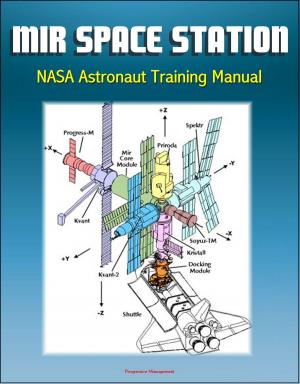Crafting Flight: Aircraft Pioneers and the Contributions of the Men and Women of NASA Langley Research Center - NACA Aviation History, Apollo Moon Landing, Viking Mars, Jet Airplanes, Wind Tunnels
Nonfiction, Reference & Language, Transportation, Aviation, History, Science & Nature, Technology, Aeronautics & Astronautics| Author: | Progressive Management | ISBN: | 9781311478375 |
| Publisher: | Progressive Management | Publication: | May 4, 2015 |
| Imprint: | Smashwords Edition | Language: | English |
| Author: | Progressive Management |
| ISBN: | 9781311478375 |
| Publisher: | Progressive Management |
| Publication: | May 4, 2015 |
| Imprint: | Smashwords Edition |
| Language: | English |
Professionally converted for accurate flowing-text e-book format reproduction, this exceptional book provides a great history of NASA Langley Research Center's contributions to aviation and spaceflight. You will read about one of the Nation's oldest research and development facilities, a place of imagination and ingenuity. If this is your first "visit," you will surely find many surprises. If you are a veteran, the pictures and text will evoke many memories.
Chapter 1 - Craving Flight * Chapter 2 - A Laboratory for Flight * Chapter 3 - Refining the Airplane * Chapter 4 - Swords and Plowshares * Chapter 5 - Beyond the Home Planet * Chapter 6 - Expertise Applied * Chapter 7 - Redefining Roles * Chapter 8 - Beyond the First One Hundred Years
One hundred years of flight is quite a historical achievement. We have progressed from a 57-second flight over the dunes of Kitty Hawk to the over 25-year journeys of Voyager 1 and 2 beyond Pluto's orbit. During that time span, in perhaps the most awe-inspiring aerospace accomplishment after Wilbur and Orville Wright's historic flight, the first humans, Neil Armstrong, Buzz Aldrin, and Michael Collins, flew to the Moon. Sixty-six years after the flight at Kitty Hawk, people all across our home planet Earth paused to watch on television as American astronaut Neil Armstrong stepped out of the Lunar Lander onto the surface of the Moon.
As we pause to celebrate the centennial of flight from our perspective in the early part of the twenty-first century, we can look back over the countless contributions of many individuals to flight. The first person who looked to the sky, observed birds in flight, and dreamed of humans soaring through the air is lost in history. Recounted in these pages are the stories of a few aviation pioneers and the contributions of the men and women of Langley Research Center. We celebrate not only their accomplishments, but also their perseverance and dedication.
A Congressional mandate issued in 1915 formed the National Advisory Committee for Aeronautics (NACA). In 1958, Congress mandated the National Aeronautics and Space Administration (NASA) from the NACA. Both the NACA and NASA were created in response to the need for the united States to catch up to existing technological advances. Although the United States was the birthplace of controlled, powered flight, by World War I, we were technologically far behind Germany, France, and Great Britain. The NACA was created to study the problems of flight "with a view to their practical solution." In 1958 when the former Soviet Union launched the first artificial satellite to orbit the Earth, the United States again found itself behind technologically, Congress passed the National Aeronautics and Space Administration Act of 1958 "to provide for research into problems of flight within and outside the Earth's atmosphere."
Professionally converted for accurate flowing-text e-book format reproduction, this exceptional book provides a great history of NASA Langley Research Center's contributions to aviation and spaceflight. You will read about one of the Nation's oldest research and development facilities, a place of imagination and ingenuity. If this is your first "visit," you will surely find many surprises. If you are a veteran, the pictures and text will evoke many memories.
Chapter 1 - Craving Flight * Chapter 2 - A Laboratory for Flight * Chapter 3 - Refining the Airplane * Chapter 4 - Swords and Plowshares * Chapter 5 - Beyond the Home Planet * Chapter 6 - Expertise Applied * Chapter 7 - Redefining Roles * Chapter 8 - Beyond the First One Hundred Years
One hundred years of flight is quite a historical achievement. We have progressed from a 57-second flight over the dunes of Kitty Hawk to the over 25-year journeys of Voyager 1 and 2 beyond Pluto's orbit. During that time span, in perhaps the most awe-inspiring aerospace accomplishment after Wilbur and Orville Wright's historic flight, the first humans, Neil Armstrong, Buzz Aldrin, and Michael Collins, flew to the Moon. Sixty-six years after the flight at Kitty Hawk, people all across our home planet Earth paused to watch on television as American astronaut Neil Armstrong stepped out of the Lunar Lander onto the surface of the Moon.
As we pause to celebrate the centennial of flight from our perspective in the early part of the twenty-first century, we can look back over the countless contributions of many individuals to flight. The first person who looked to the sky, observed birds in flight, and dreamed of humans soaring through the air is lost in history. Recounted in these pages are the stories of a few aviation pioneers and the contributions of the men and women of Langley Research Center. We celebrate not only their accomplishments, but also their perseverance and dedication.
A Congressional mandate issued in 1915 formed the National Advisory Committee for Aeronautics (NACA). In 1958, Congress mandated the National Aeronautics and Space Administration (NASA) from the NACA. Both the NACA and NASA were created in response to the need for the united States to catch up to existing technological advances. Although the United States was the birthplace of controlled, powered flight, by World War I, we were technologically far behind Germany, France, and Great Britain. The NACA was created to study the problems of flight "with a view to their practical solution." In 1958 when the former Soviet Union launched the first artificial satellite to orbit the Earth, the United States again found itself behind technologically, Congress passed the National Aeronautics and Space Administration Act of 1958 "to provide for research into problems of flight within and outside the Earth's atmosphere."















